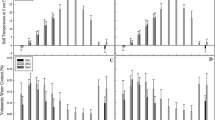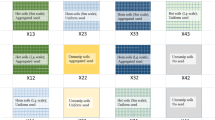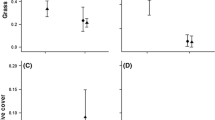Abstract
Recruitment of species into plant communities requires the arrival of viable propagules to coincide with the availability of suitable microsites for establishment. Accordingly, the rarity of recruitment events due to seed and/or microsite limitations may constrain the establishment, diversity, and spatial distribution of species in plant communities, thus potentially mediating stochastic recruitment—herein described as probabilistic and unpredictable patterns of species establishment over space that can emerge in the absence or in spite of environmental heterogeneity. To examine this premise, we applied a gradient of propagule pressure, using 37 native forb species, to plots subjected to disturbances of varying intensity in a low-diversity grassland restoration in Eastern Kansas, USA. We monitored establishment for three years, assessing the effects of propagule pressure and disturbance on sown species stem density, richness, composition, and community dissimilarity. Seed limitation was the primary constraint on species richness in this grassland, but both propagule pressure and disturbance had positive, interactive effects on stem density. Increased propagule pressure enhanced recruitment and reduced community dissimilarity among disturbance treatment replicates, thus tempering stochastic recruitment. High propagule pressure led to compositional divergence among disturbance treatments, indicative of deterministic species sorting. These results suggest that seed limitation and stochastic recruitment have important implications for beta diversity and spatial structuring of plant community species compositions, acting to (1) generate and maintain beta diversity by producing stochastic spatial variation in species composition among environmentally similar localities; while concurrently (2) limiting beta diversity by constraining the expression of niche-based species sorting in response to environmental heterogeneity.



Similar content being viewed by others
References
Anderson MJ (2001) A new method for non-parametric multivariate analysis of variance. Austral Ecol 26:32–46
Anderson MJ (2004) PERMDISP: a FORTRAN computer program for permutational analysis of multivariate dispersions (for any two-factor ANOVA design) using permutation tests. Department of Statistics, University of Auckland, New Zealand
Anderson MJ (2006) Distance-based tests for homogeneity of multivariate dispersions. Biometrics 62:245–253
Anderson MJ, Gorley RN, Clark KR (2008) PERMANOVA + for PRIMER: Guide to Software and Statistical Methods, PRIMER-E. Plymouth, UK
Camill P, McKone MJ, Sturges ST, Severud WJ, Ellis E, Limmer J, Martin CB, Navratil RT, Purdie AJ, Sandel BS, Talukder S, Trout A (2004) Community- and ecosystem-level changes in a species-rich tallgrass prairie restoration. Ecol Appl 14:1680–1694
Chase JM (2003) Community assembly: when should history matter? Oecologia 136:489–498
Chase JM (2005) Towards a really unified theory for metacommunities. Funct Ecol 19:182–186
Chase JM (2010) Stochastic community assembly causes higher biodiversity in more productive environments. Science 328:1388–1391
Collins SL (1992) Fire frequency and community heterogeneity in tallgrass prairie vegetation. Ecology 73:2001–2006
Copeland TE, Sluis W, Howe HF (2002) Fire season and dominance in an Illinois tallgrass prairie restoration. Restor Ecol 10:315–323
Davis MA, Pelsor M (2001) Experimental support for a resource-based mechanistic model of invasibility. Ecol Lett 4:421–428
Davis MA, Grime JP, Thompson K (2000) Fluctuating resources in plant communities: a general theory of invasibility. J Ecol 88:528–534
Dufrene M, Legendre P (1997) Species assemblages and indicator species: the need for a flexible asymmetrical approach. Ecol Monogr 67:345–366
Eriksson O, Ehrlén J (1992) Seed and microsite limitation of recruitment in plant populations. Oecologia 91:360–364
Facelli JM, Facelli E (1993) Interactions after death: plant litter controls priority effects in a successional plant community. Oecologia 95:277–282
Foster BL (2001) Constraints on colonization and species richness along a grassland productivity gradient: the role of propagule availability. Ecol Lett 4:530–535
Frances AL, Adams CR, Norcini JG (2010) Importance of seed and microsite limitation: native wildflower establishment in non-native pasture. Restor Ecol 18:944–953
Gotelli NJ, Entsminger GL (2009) EcoSim: Null models software for ecology, Version 7.72 Acquired Intelligence Inc, and Kesey-Bear. http://garyentsminger.com/ecosim.htm
Gravel D, Canham CD, Beaudet M, Messier C (2006) Reconciling niche and neutrality: the continuum hypothesis. Ecol Lett 9:399–409
Jutila HM, Grace JB (2002) Effects of disturbance on germination and seedling establishment in a coastal prairie grassland: a test of the competitive release hypothesis. J Ecol 90:291–302
Kettle WD, Rich PM, Kindscher K, Pittman G, Fu P (2000) Land-use history in ecosystem restoration: a 40-year study in the prairie-forest ecotone. Restor Ecol 8:307–317
Kindscher K, Tieszen LL (1998) Floristic and soil organic matter changes after five and thirty-five years of native tallgrass prairie restoration. Restor Ecol 6:181–196
Knapp AK, Seastedt TR (1986) Detritus accumulation limits productivity of tallgrass prairie. Bioscience 36:662–668
Leibold MA, Holyoak M, Mouquet N, Amarasekare P, Chase JM, Hoopes MF, Holt RD, Shurin JB, Law R, Tilman D, Loreau M, Gonzalez A (2004) The metacommunity concept: a framework for multi-scale community ecology. Ecol Lett 7:601–613
Long Q (2010) Species coexistence in restored grassland plant communities: Trait-based recruitment, niche-neutral assembly and heterogeneous management. Dissertation, University of Kansas
MacDougall AS, Turkington R (2007) Does the type of disturbance matter when restoring disturbance-dependent grasslands? Restor Ecol 15:263–272
Martin LM, Moloney KA, Wilsey BJ (2005) An assessment of grassland restoration success using species diversity components. J Appl Ecol 42:327–336
McCune B, Mefford MJ (1999) PC-ORD. Multivariate analysis of ecological data. Version 5.0. In: MjM Software Design Gleneden Beach, Oregon, USA
Mouquet N, Leadley P, Meriguet J, Loreau M (2004) Immigration and local competition in herbaceous plant communities: a three-year seed-sowing experiment. Oikos 104:77–90
Myers JA, Harms KE (2009) Seed arrival, ecological filters, and plant species richness: a meta-analysis. Ecol Lett 12:250–1260
Orrock JL, Fletcher RJ (2005) Changes in community size affect the outcome of competition. Am Nat 166:107–111
Orrock JL, Watling JI (2010) Local community size mediates ecological drift and competition in metacommunities. Proc R Soc B 277:2185–2191
Polley HW, Derner JD, Wilsey (2005) Patterns of plant species diversity in remnant and restored tallgrass prairies. Restor Ecol 13:480–487
Samson F, Knopf F (1994) Prairie conservation in North America. Bioscience 44:418–421
Stevens MHH, Bunker DE, Schnitzer SA, Carson WP (2004) Establishment limitation reduces species recruitment and species richness as soil resources rise. J Ecol 92:339–347
Tilman D (1993) Species richness of experimental productivity gradients: how important is colonization limitation. Ecology 74:2179–2191
Tilman D (1997) Community invasibility, recruitment limitation, and grassland biodiversity. Ecology 79:81–92
Tilman D (2004) Niche tradeoffs, neutrality, and community structure: a stochastic theory of resource competition, invasion, and community assembly. Proc Natl Acad Sci USA 101:10854–10861
Turnbull LA, Crawley MJ, Rees M (2000) Are plant populations seed-limited? A review of seed sowing experiments. Oikos 88:225–238
USDA-NRCS (2013) The PLANTS Database. URL http://plants.usda.gov
Wan SQ, Hui DF, Luo YQ (2001) Fire effects on nitrogen pools and dynamics in terrestrial ecosystems: a meta-analysis. Ecol Appl 11:1349–1365
Weaver JE, Fitzpatrick TJ (1934) The prairie. Ecol Monogr 4:109–295
Xiong S, Johansson ME, Hughes FMR, Hayes A, Richards KS, Nilsson C (2003) Interactive effects of soil moisture, vegetation canopy, plant litter and seed addition on plant diversity in a wetland community. J Ecol 91:976–986
Acknowledgments
Funding was provided by Prairie Fork Trust and the University of Kansas Ecological Reserves, with support from NSF Grant # 0950100 and the Madison and Lila Self Graduate Fellowship. Bernadette Kuhn and Joel Harvester provided invaluable field assistance. Matthew Albrecht, Ford Ballantyne IV, Adam Smith, and three anonymous reviewers provided insightful comments to improve this manuscript.
Author information
Authors and Affiliations
Corresponding author
Additional information
Communicated by J. Price.
Electronic supplementary material
Below is the link to the electronic supplementary material.
Rights and permissions
About this article
Cite this article
Long, Q., Foster, B.L. & Kindscher, K. Seed and microsite limitations mediate stochastic recruitment in a low-diversity prairie restoration. Plant Ecol 215, 1287–1298 (2014). https://doi.org/10.1007/s11258-014-0387-y
Received:
Accepted:
Published:
Issue Date:
DOI: https://doi.org/10.1007/s11258-014-0387-y




